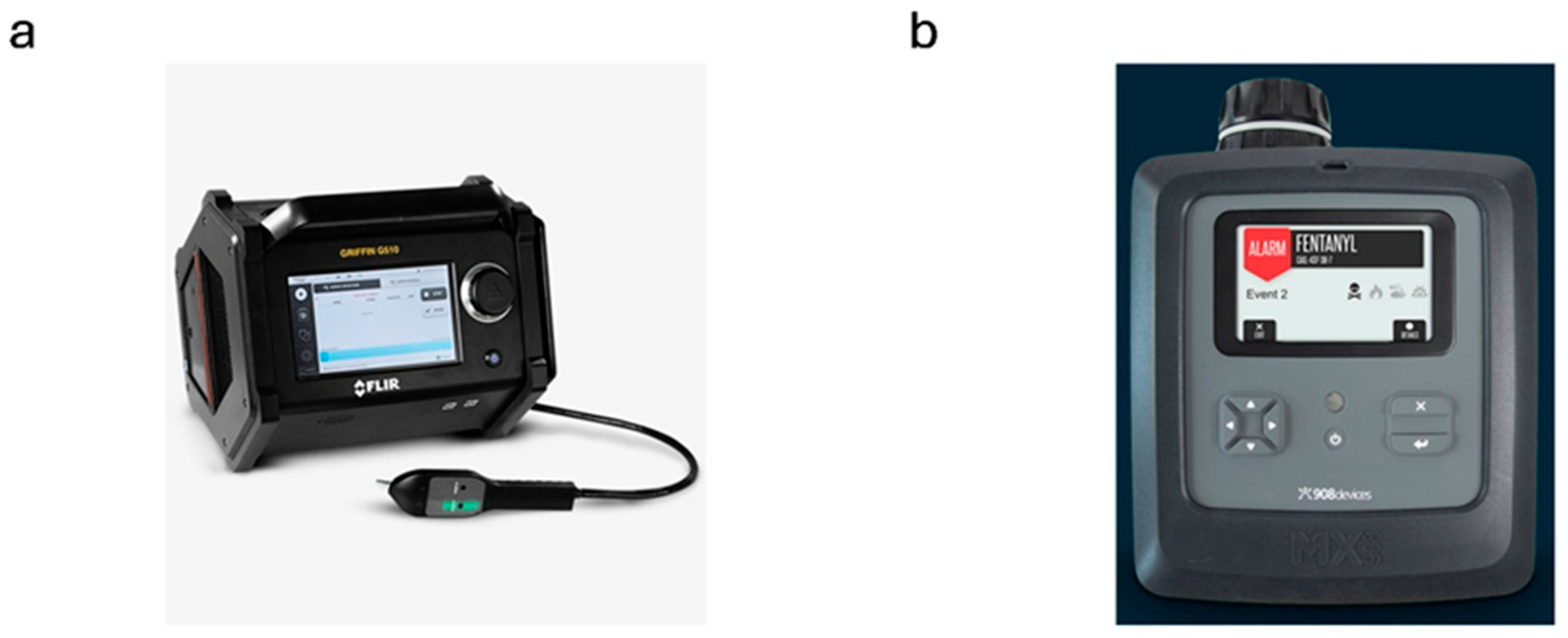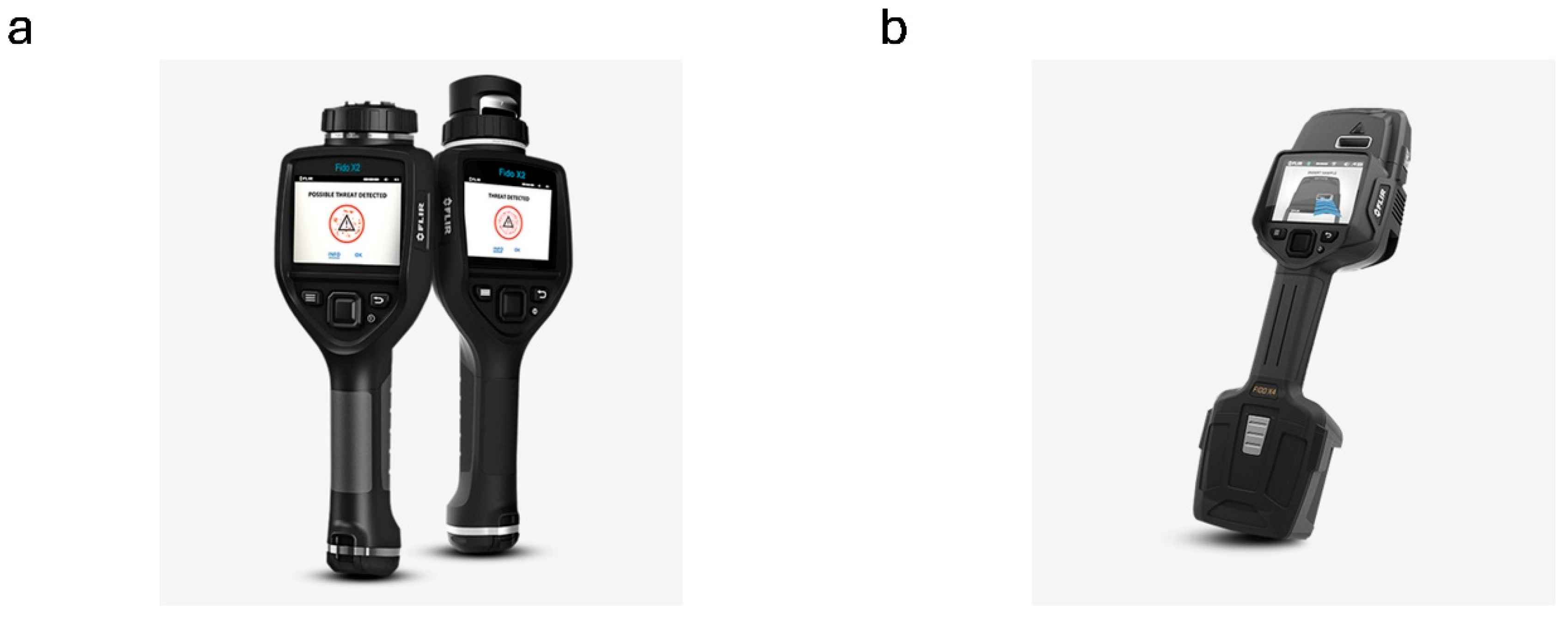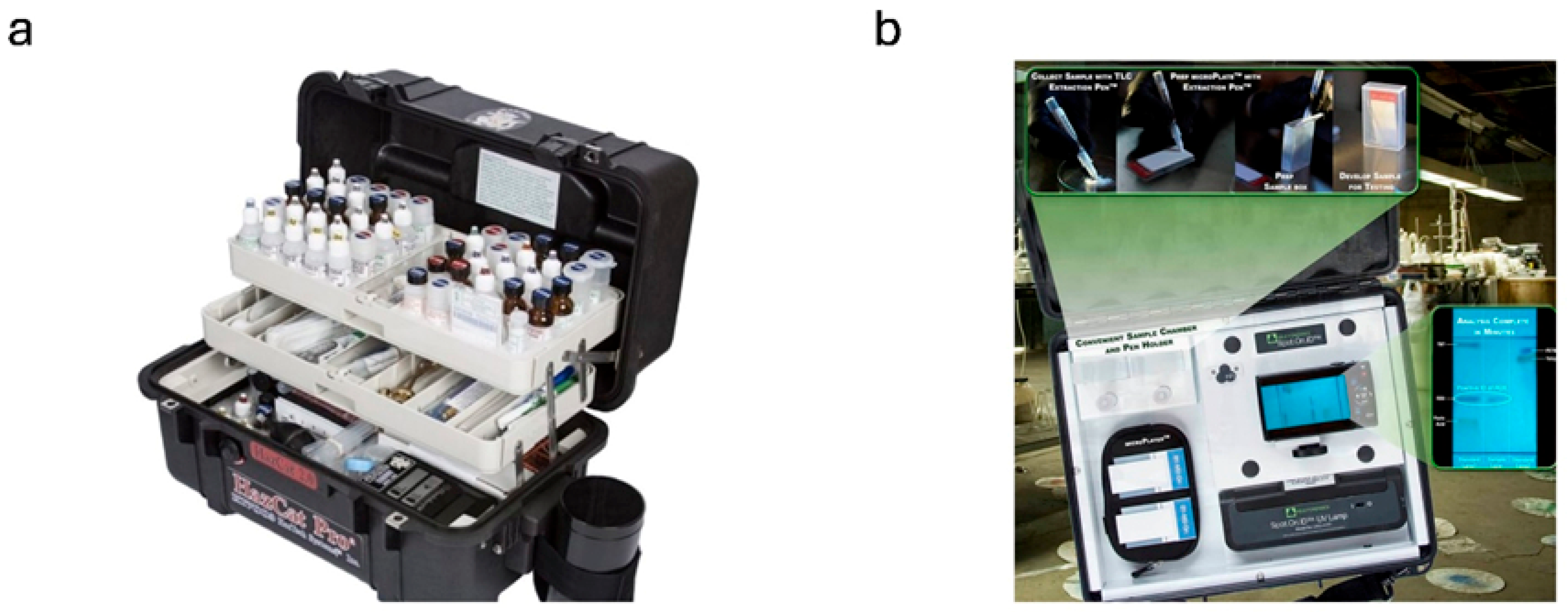Field Explosives Detectors—Current Status and Development Prospects
Abstract
Highlights
- A review of ~80 commercially available mobile explosive detectors revealed wide technological diversity, from IMS and FTIR to GC–MS and QCM.
- Only a few devices use two orthogonal techniques, significantly improving detection reliability and reducing false alarms.
- Multi-technique approaches are essential to enhance explosive detection’s accuracy, efficiency, and robustness in real-world scenarios.
- The results provide practical guidance for selecting and developing portable detection systems for security, defense, and emergency response.
Abstract
1. Introduction
2. Ion Mobility Spectrometry (IMS)
3. Raman Spectroscopy

Surface-Enhanced Raman Scattering Technique
4. Fourier Transform Infrared Spectroscopy (FTIR)
5. Mass Spectrometry
| Manufacturer/Detector Name. | Detectable Substances | The Physical State of the Sample | Limit of Detection/Mass Range | Weight of the Device | References |
|---|---|---|---|---|---|
| Teledyne FLIR Detection, Inc./Griffin™ G510 | Explosives, Chemical Agents, ITF-25 TIC/TIMs, Narcotics, Other Chemical Targets | Vapor/Gas, Liquid, Solid | ppm, ppb, ng 15–515 m/z | 16.3 kg | [101] |
| Kore Technology Ltd./Kore MS-200 | Explosives, Chemical Agents, ITF-25 TIC/TIMs, Narcotics, Other Chemical Targets | Vapor/Gas | ppb 1–1000 m/z | 23.0 kg | [102] |
| 908 Devices, Inc./MX908 | Explosives (ETN, HMTD, HMX, MEKP, PETN, RDX, TNT, TATP, nitrobenzene and more), Chemical Agents (A-series (Novichoks), HD, GA, GB, GD, GF, VX plus additional V-series agents.), ITF-25 TIC/TIMs (DEEP, DIMP, TEP, GD acid, TMP, dimethyl sulfate, carbon disulfide, allyl amine, allyl alcohol), Narcotics (Fentanyl, fentanyl analogs, U-47700, hydrocodone, oxycodone, heroin, cocaine, amphetamines, ephedrine, MDMA, methadone, methamphetamine, carfentanil, sufentanil, alfentanil, remifentanil, ketamine and more.) Other Chemical Targets (Solid organic materials) | Vapor/Gas, Liquid, Solid | ppb, ng, µg | 4.3 kg | [103] |
| Bay Spec/Portability™ Transportable Mass Spectrometer | Explosives, CWAs, TICs, Pesticides, Narcotics | Aerosol/Gaz/Ciecz Ciało stałe | ppt 50–600 amu 0.49 amu | 10.0 kg | [104] |
| Perkin Elmer/Torion T-9 | Explosives (most organic explosives), Chemical Agents, ITF-25 TIC/TIMs, Narcotics, and Other Chemical Targets | Vapor/Gas, Liquid, Solid | ppb 41–500 m/z | 14.5 kg | [105] |
6. Laser Induced Fluorescence (LIF)
7. Quartz Crystal Microbalance (QCM)
8. Colorimetric Detection of Explosives
8.1. Colorimetric Detection of Explosives Interpreted by the Operator
8.2. Colorimeters
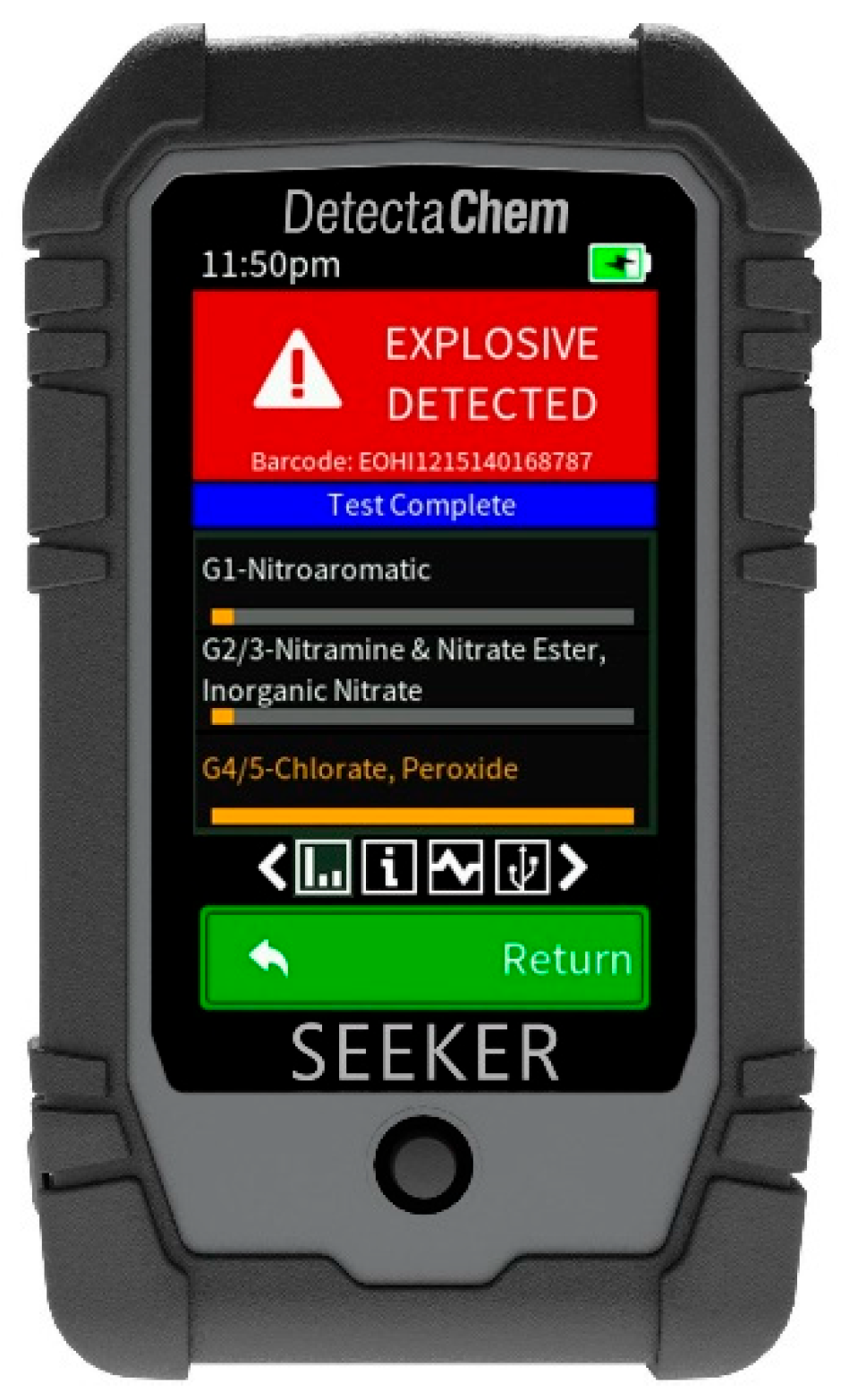
9. Coupling Raman Spectroscopy with FTIR
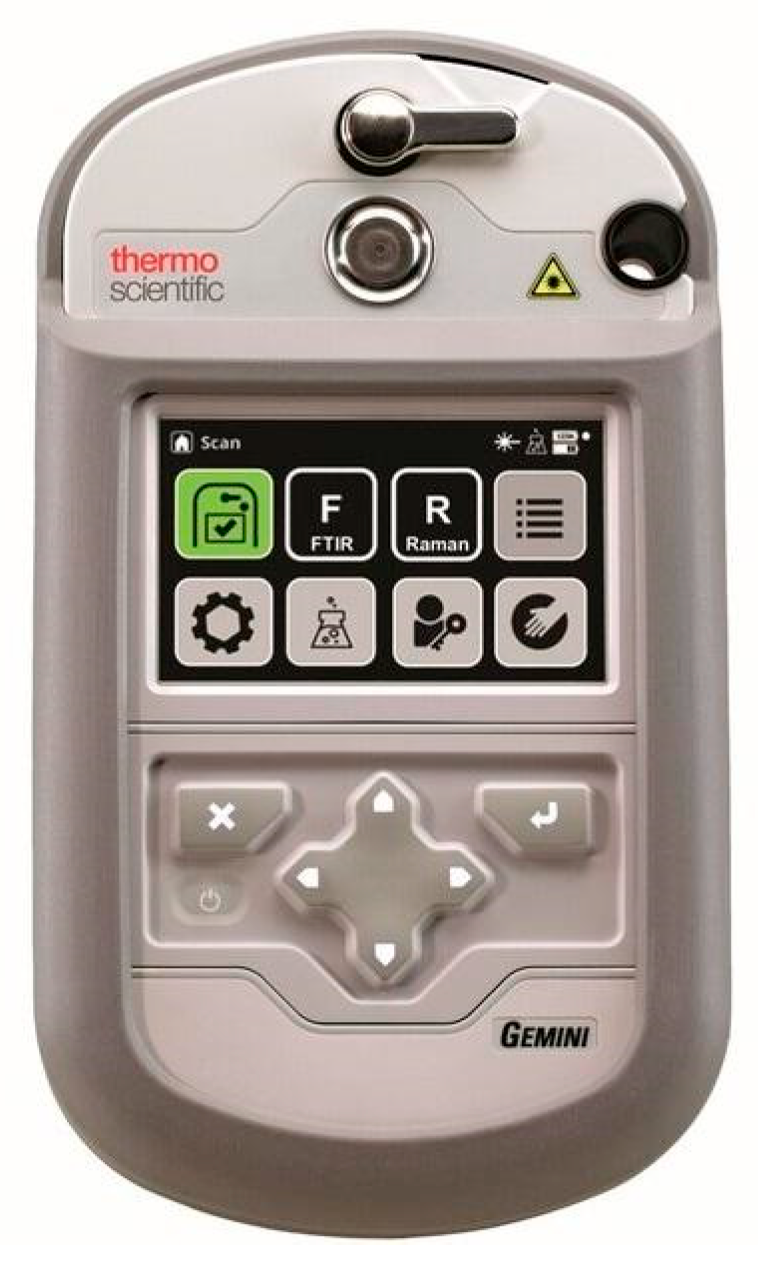

10. IMS Coupling with an Electrochemical Sensor
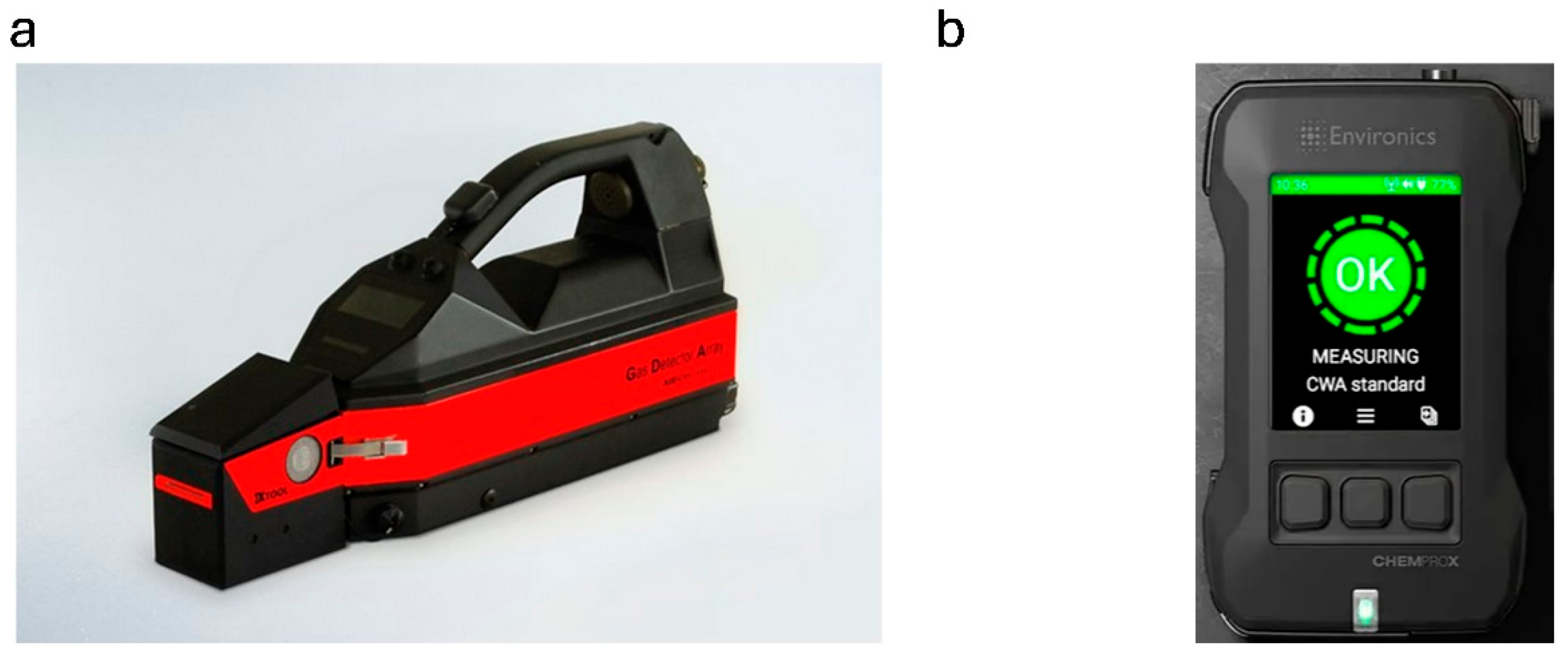
11. Conclusions
Author Contributions
Funding
Institutional Review Board Statement
Informed Consent Statement
Data Availability Statement
Acknowledgments
Conflicts of Interest
Abbreviations
| CWA | Chemical Warfare Agents |
| TIC/TIMs | TIC Toxic Industrial Chemicals, TIM Toxic Industrial Materials) |
| TNT | 2,4,6 Trinitrotoluene |
| RDX | Hexogen, 1,3,5-Trinitro-1,3,5-triazinane |
| NG | Nitroglycerin, Propane-1,2,3-triyl Trinitrate |
| AN | Ammonium Nitrate |
| PETN | Pentaerythritol Tetranitrate, 2,2-Bis[(nitrooxy)methyl]propane-1,3-diyl Dinitrate |
| EGDN | Ethylene Glycol Dinitrate, Ethane-1,2-diyl Dinitrate |
| HMX | Octogen, 1,3,5,7-Tetranitro-1,3,5,7-tetraazacyklooktan |
| THC | Tetrahydrocannabinol |
| U-47700 | (3,4-Dichlorophenyl)-[1-(2-dimethylamino)cyclohexyl]methanone, a drug from the family of synthetic opioids |
| GB | Sarin, Propan-2-yl Methylphosphonofluoridate |
| VX | S-{2-[Di(propane-2-yl)amino]ethyl} O-ethyl Methylphosphonothioate |
| GA | Tabun, RS)-Ethyl N,N-Dimethylphosphoramidocyanidate |
| GD | Soman, 3,3-Dimethylbutan-2-yl Methylphosphonofluoridate |
| GF | Cyclosarin, Cyclohexyl Methylphosphonofluoridate |
| AC | Hydrogen Cyanide, Methanenitrile |
| CG | Phosgene, Carbonyl Dichloride |
| CX | Phosgene Oxime, 1,1-Dichloro-N-hydroxymethanimine |
| HD | Mustard Gas, 1-Chloro-2-[(2-chloroethyl)sulfanyl]ethane |
| HL | A Mixture of Mustard Gas with Lewisite |
| PD | Phenyldichloroarsine, Dichloro(fenylo)arsyna |
| L | Lewisite, [(E)-2-Chloroethen-1-yl]arsonous Dichloride |
| HN | Nitrogen Mustards, (Bis(2-chloroethyl)ethylamine) |
| HCN | Hydrogen Cyanide, Formonitrile |
| HCl | Hydrochloric Acid |
| NH3 | Ammonia |
| CH4 | Methane |
| HF | Hydrofluoric Acid |
| As | Arsenic |
| TATP | Triacetonetriperoxide, 3,3-Dimethyl-1,2-dioxacyclopropane |
| DMNB | 2,3-Dimethyl-2,3-dinitrobutane |
| ANFO | Ammonium nitrate/Fuel oil |
| ppm | Parts Per Million |
| ppb | Parts Per Billion |
| ppt | Parts Per Trillion |
| MDMA | 3,4-Methylenedioxymethamphetamine |
| MDA | 3,4-Methylenedioxyamphetamine |
| PCP | Phencyclidine |
| PMA | 4-Methoxyamphetamine |
| GHB | 4-Hydroxybutyric acid |
| SERS | Surface-Enhanced Raman Spectroscopy |
References
- Yinon, J. Counterterrorist Detection Techniques of Explosives; Elsevier: Amsterdam, The Netherlands, 2007. [Google Scholar]
- Kagan, A.; Oxley, J.C. Counterterrorist Detection Techniques of Explosives, 2nd ed.; Elsevier: Amsterdam, The Netherlands, 2022. [Google Scholar]
- Prante, M.; Ude, C.; Groβe, M.; Raddatz, L.; Krings, U.; John, G.; Belkin, S.; Scheper, T. A Portable Biosensor for 2,4-dnitrotoluene Vapors. Sensors 2018, 18, 4247. [Google Scholar] [CrossRef]
- Lu, X.; Hao, P.; Xie, G.; Duan, J.; Gao, L.; Liu, B. A Sensor Array Realized by a Single Flexible TiO2/POMs Film to Contactless Detection of Triacetone Triperoxide. Sensors 2019, 19, 915. [Google Scholar] [CrossRef]
- Xie, G.; Liu, B. Fingerprinting of Nitroaromatic Explosives Realized by Aphen-functionalized Titanium Dioxide. Sensors 2019, 19, 2407. [Google Scholar] [CrossRef]
- MIL-STD-810H; Test Method Standard Environmental Engineering Considerations and Laboratory Tests. Department of Defense USA: Arlington, VA, USA, 2019.
- Caygill, J.S.; Davis, F.; Higson, S.P.J. Current trends in explosive detection techniques. Talanta 2012, 88, 14–29. [Google Scholar] [CrossRef]
- Mokalled, L.; Al-Husseini, M.; Kabalan, K.Y.; El-Hajj, A. Sensor Review for Trace Detection of Explosives. Int. J. Sci. Eng. Res. 2014, 5, 6. [Google Scholar]
- Rahimi, F.; Chatzimichail, S.; Saifuddin, A.; Surman, J.; Taylor-Robinson, S.D.; Reyhani, A.S. A Review of Portable High-Performance Liquid Chromatography: The Future of the Field? Chromatographia 2020, 83, 1165–1195. [Google Scholar] [CrossRef]
- Paul, T.; Choudhury, D.R.; Ghosh, D.; Saha, C. Advancements in Optical Sensors for Explosive Materials Identification: A Comprehensive Review. Results Chem. 2024, 8, 100298. [Google Scholar] [CrossRef]
- Klapec, D.J.; Czarnopys, G.; Pannuto, J. Interpol review of detection and characterization of explosives and explosives residues 2016–2019. Forensic Sci. Int. Synerg. 2020, 2, 670–700. [Google Scholar] [CrossRef]
- Klapec, D.J.; Czarnopys, G.; Pannuto, J. Interpol review of the analysis and detection of explosives and explosives residues. Forensic Sci. Int. Synerg. 2023, 6, 100298. [Google Scholar] [CrossRef]
- Kada, J.; Decker, K. Explosives Trace Detectors (ETDs) Market Survey Report; National Urban Security Technology Laboratory, U.S. Department of Homeland Security: Manhattan, NY, USA, 2021. [Google Scholar]
- Yinon, J. Detection of Explosives by Electronic Noses. Anal. Chem. 2003, 1, 99–105. [Google Scholar] [CrossRef]
- Strle, D.; Štefane, B.; Trifković, M.; van Midden, M.; Kvasic, I.; Zupanič, E.; Muševič, I. Chemical Selectivity and Sensitivity of a 16-Channel Electronic Nose for Trace Vapour Detection. Sensors 2017, 17, 2845. [Google Scholar] [CrossRef]
- Gradišek, A.; van Midden, M.; Koterle, M.; Prezelj, V.; Strle, D.; Štefane, B.; Brodnik, H.; Trifković, M.; Kvasic, I.; Zupanič, E.; et al. Improving the Chemical Selectivity of an Electronic Nose to TNT, DNT and RDX Using Machine Learning. Sensors 2019, 19, 5207. [Google Scholar] [CrossRef]
- Maziejuk, M.; Szyposzyńska, M.; Spławska, A.; Wiśnik-Sawka, M.; Ceremuga, M. Detection of Triacetone Triperoxide (TATP) and Hexamethylene Triperoxide Diamine (HMTD) from the Gas Phase with Differential Ion Mobility Spectrometry (DMS). Sensors 2021, 21, 4545. [Google Scholar] [CrossRef]
- Szyposzyńska, M.; Spławska, A.; Ceremuga, M.; Kot, P.; Maziejuk, M. Stationary Explosive Trace Detection System Using Differential Ion Mobility Spectrometry (DMS). Sensors 2023, 23, 8586. [Google Scholar] [CrossRef]
- Available online: https://afcintl.com/p/accusense-chemical-recognition-system/ (accessed on 24 July 2025).
- Available online: https://www.cbrnetechindex.com/P/4374/Seer-Technology-Inc/AccuSense (accessed on 24 July 2025).
- Available online: https://www.seertechnology.com/technical-specifications (accessed on 26 September 2025).
- Available online: https://www.cbrnetechindex.com/SupportDocuments/0e2cf787-3232-437f-8861-ac52e33b7d17Scintrex%20-%20EN3300.pdf (accessed on 25 July 2025).
- Available online: https://leidos.widen.net/s/nkz8jtnhmg/21-273139-h150e-fs-digital (accessed on 26 September 2025).
- Available online: https://www.leidos.com/sites/leidos/files/2020-07/FS-Leidos-H150E.pdf (accessed on 26 July 2025).
- Available online: https://www.smithsdetection.com/products/lcd-4/ (accessed on 26 July 2025).
- Available online: https://autoclear.com/trace-detection/n2300-trace-detector/ (accessed on 26 July 2025).
- Available online: https://www.bruker.com/en/products-and-solutions/cbrne-detectors/ims/roadrunner.html (accessed on 26 July 2025).
- Available online: https://xraybaggagescanner.buy.lightneasy.org/pz63fca60-spe300-drug-bomb-detector-machine-tft-color-touch-screen-for-airport.html (accessed on 27 July 2025).
- Available online: https://www.nuctech.com/en/SitePages/ThDetailPage.aspx?nk=PAS&k=BHFCEF&pk=FGAFHB (accessed on 27 July 2025).
- Available online: https://www.smithsdetection.com/products/ionscan-600/ (accessed on 27 July 2025).
- Available online: https://www.secuplusinspection.com/product/SPE9000-New-Explosives-and-narcotics-trace-detector(Table-set-explosives-detector-)-16.html (accessed on 27 July 2025).
- Available online: https://www.owlstoneinc.com/products/lonestar/ (accessed on 28 July 2025).
- Available online: https://inwdt.com/solution-products/detectors/VexTrace-explosive-vapor-and-trace-detector/ (accessed on 28 July 2025).
- Available online: https://www.rapiscansystems.com/en/products/mobiletrace (accessed on 29 July 2025).
- Available online: https://www.cbrnetechindex.com/SupportDocuments/a268f76b-99e6-4e96-8672-964c3a305031Rapiscan%20Systems%20-%20MobileTrace.pdf (accessed on 29 July 2025).
- Available online: http://www.sibel.info/production/ENG/MO-2M/MO-2M_technical_description.pdf (accessed on 29 July 2025).
- Kuehn, M.; Bates, K.; Davidson, J.T.; Monjardez, G. Evaluation of handheld Raman spectrometers for the detection of intact explosives. Forensic Sci. Int. 2023, 353, 111875. [Google Scholar] [CrossRef]
- Liszewska, M.; Bartosewicz, B.; Budner, B.; Szala, M.; Miczuga, M.; Kopczyński, K.; Jankiewicz, B. Spektroskopia Ramana w zakresie niskich częstotliwości w badaniach materiałów wybuchowych. Przemysł Chem. 2020, 99, 1469–1476. [Google Scholar] [CrossRef]
- Available online: https://optosky.com/image/catalog/pdf/ATR6200%20Handheld%20Raman%20analyzer.pdf (accessed on 30 July 2025).
- Available online: https://optosky.com/image/catalog/pdf/ATR6500_datasheet%20V2.4_march,2021.pdf (accessed on 30 July 2025).
- Available online: https://optosky.com/image/catalog/pdf/atr6600_datasheet_March%202021.pdf (accessed on 30 July 2025).
- Available online: https://www.bruker.com/pl/products-and-solutions/infrared-and-raman/raman-spectrometers/bravo-handheld-raman-spectrometer.html?page_1=1 (accessed on 30 July 2025).
- Available online: https://www.cbrnetechindex.com/P/6343/Coda-Devices-Inc/CDI-2 (accessed on 30 July 2025).
- Available online: https://www.anton-paar.com/pl-pl/produkty/szczegoly/reczny-spektrometr-ramana-cora-100/ (accessed on 1 August 2025).
- Available online: https://rigaku.com/products/handheld-raman/cql-gen-id (accessed on 1 August 2025).
- Available online: https://rigaku.com/products/handheld-raman/cql-max-id (accessed on 1 August 2025).
- Available online: https://www.thermofisher.com/order/catalog/product/FIRSTDEFENDERRM (accessed on 4 August 2025).
- Available online: https://www.thermofisher.com/order/catalog/product/FIRSTDEFENDERRMX (accessed on 4 August 2025).
- Available online: https://www.rsdynamics.com/products/raman/microraman/?gad_source=1&gclid=EAIaIQobChMIl9i34fa-hgMViKhoCR3XxQfPEAAYASAAEgJVTfD_BwE (accessed on 4 August 2025).
- Available online: https://dekontacbrn.cz/wp-content/uploads/2022/06/miniSPECTRE_Brochure.pdf (accessed on 4 August 2025).
- Available online: https://www.metrohm.com/pl_pl/produkty/spektrometry-ramana/spektrometr-mira-xtr.html (accessed on 4 August 2025).
- Available online: https://www.metrohm.com/pl_pl/produkty/spektrometry-ramana/spektrometr-nanoram.html (accessed on 4 August 2025).
- Available online: https://www.pendar.com/products/pendar-x10-handheld-raman/ (accessed on 5 August 2025).
- Available online: https://www.chemring.com/~/media/Files/C/Chemring-V3/documents/sensors/datasheet-pgr-1064v1.pdf (accessed on 5 August 2025).
- Available online: https://agiltron.com/product/handheld-raman-spectrometer/ (accessed on 5 August 2025).
- Available online: https://rigaku.com/products/handheld-raman/progeny (accessed on 5 August 2025).
- Available online: https://biotools.us/ramtest/ (accessed on 5 August 2025).
- Available online: https://www.agilent.com/en/product/molecular-spectroscopy/raman-spectroscopy/handheld-raman-chemical-detection-systems (accessed on 5 August 2025).
- Available online: https://www.nuctech.com.ar/en/producto/nuctech-rt6000s-substance-identifier/ (accessed on 5 August 2025).
- Available online: https://serstech.com/wp-content/uploads/2019/12/Serstech100IndicatorUserManualforVers.5.4.2.pdf (accessed on 26 September 2025).
- Available online: https://www.stellarnet.us/analyzers/stellarram-handheld-raman-system-for-material-identification/ (accessed on 5 August 2025).
- Available online: https://www.metrohm.com/pl_pl/produkty/spektrometry-ramana/spektrometr-tacticid.html (accessed on 5 August 2025).
- Available online: https://www.thermofisher.com/order/catalog/product/TRUSCANRM (accessed on 7 August 2025).
- Available online: https://www.agilent.com/en/product/molecular-spectroscopy/raman-spectroscopy/raman-pharmaceutical-analysis-systems/vaya-handheld-raman-spectrometer-for-raw-material-identification (accessed on 7 August 2025).
- Available online: https://www.cbrnetechindex.com/SupportDocuments/cfa7dac4-3ebc-4f90-b631-5034f17ed7a9Horiba%20-%20AnywhereRaman.pdf (accessed on 7 August 2025).
- Available online: https://cbrnetechindex.com/p/6342/Coda-Devices-Inc/CDI-1M (accessed on 7 August 2025).
- Available online: https://www.cbrnetechindex.com/P/3883/Metrohm/IM-52 (accessed on 7 August 2025).
- Available online: https://www.inphotonics.com/Portable-echelle.htm (accessed on 7 August 2025).
- Available online: https://www.inphotonics.com/spectrometers2.htm (accessed on 7 August 2025).
- Available online: https://www.metrohm.com/pl_pl/produkty/spektrometry-ramana/spektrometr-i-raman.html (accessed on 7 August 2025).
- Available online: https://optosky.com/index.php?route=product/search&search=Portable%20Raman%20Analyzer%20&category_id=0 (accessed on 7 August 2025).
- Available online: https://www.cbrnetechindex.com/SupportDocuments/6f1cf296-0092-4598-8eda-9e38bb929963Alakai%20-%20PRIED.pdf (accessed on 7 August 2025).
- Available online: https://www.antsltd.com/products/flipper (accessed on 7 August 2025).
- Available online: https://www.agilent.com/en/product/molecular-spectroscopy/raman-spectroscopy/raman-pharmaceutical-analysis-systems/rapid-raw-material-id-verification-system (accessed on 7 August 2025).
- Available online: https://www.stellarnet.us/analyzers/stellarcase-raman-material-identification/ (accessed on 8 August 2025).
- Kneipp, K.; Moskovits, M.; Kneipp, H. Physics and Applications. In Surface-Enhanced Raman Scattering; Topics in Applied Physics; Springer: Berlin/Heidelberg, Germany, 2006; Volume 103. [Google Scholar] [CrossRef]
- Liszewska, M.; Bartosewicz, B.; Budner, B.; Nasiłowska, B.; Szala, M.; Weyher, L.J.; Dzięcielewski, I.; Mierczyk, Z.; Jankiewicz, B. Evaluation of selected SERS substrates for trace detection of explosive materials using portable Raman systems. Vib. Spectrosc. 2019, 100, 79–85. [Google Scholar] [CrossRef]
- Adhikari, S.; Ampadu, E.K.; Kim, M.; Noh, D.; Oh, E.; Lee, D. Detection of Explosives by SERS Platform Using Metal Nanogap Substrates. Sensors 2021, 21, 5567. [Google Scholar] [CrossRef]
- Deschaines, T.O. Application of Automated Data Collection to Surface-Enhanced Raman Scattering (SERS); Application Note: 52020; Thermo Fisher Scientific: Madison, WI, USA, 2010. [Google Scholar]
- He, L.; Labuza, T.; Deschaines, T.O. Detection of Ricin in Milk Using Surface-Enhanced Raman Scattering (SERS); Application Note; Thermo Fisher Scientific: Madison, WI, USA, 2022. [Google Scholar]
- He, L.; Labuza, T.; Deschaines, T.O. Aptamer Based Surface-Enhanced Raman Scattering (SERS) for Detection of Ricin in Liquids; Application Note 52247; Thermo Fisher Scientific: Madison, WI, USA, 2011. [Google Scholar]
- Deschaines, T.O.; Wieboldt, D. Practical Applications of Surface-Enhanced Raman Scattering (SERS); Technical Note: 51874; Thermo Fisher Scientific: Madison, WI, USA, 2010. [Google Scholar]
- Available online: https://documents.thermofisher.com/TFS-Assets/CAD/Application-Notes/gemini-lowdose-id-whitepaper.pdf (accessed on 26 September 2025).
- Available online: https://www.thermofisher.com/pl/en/home/industrial/safety-security-threat-detection/instruments/gemini-analyzer-lowdose-id.html (accessed on 26 September 2025).
- Available online: https://sersitive.eu/ (accessed on 8 August 2025).
- Available online: https://www.oceanoptics.com/accessories/sampling-accessories/ (accessed on 8 August 2025).
- Available online: https://www.nikalyte.com/sers-substrates/ (accessed on 8 August 2025).
- Available online: https://www.hamamatsu.com/eu/en/applications/analytical-equipment/raman-spectroscopy.html (accessed on 8 August 2025).
- Heleg-Shabtai, V.; Zaltsman, A.; Sharon, M.; Sharabi, H.; Nir, I.; Marder, D.; Cohen, G.; Ron, I.; Pevzner, A. Explosive vapour/particles detection using SERS substrates and a hand-held Raman detector. RSC Adv. 2021, 11, 26029–26036. [Google Scholar] [CrossRef]
- Kananen, K.; Hakala, T.; Heikkinen, M.; Honkanen, M.; Hänninen, V.; Lahtinen, J.; Vainio, M. Setup and Analysis of a Mid-Infrared Stand-Off System to Detect Traces of Explosives on Fabrics. Sensors 2022, 22, 7839. [Google Scholar] [CrossRef]
- Herrero, A.; Romero, M.; Fernández, I.; Vega, L.; González, J.; González, R.; Oller, J. Rapid and On-Scene Chemical Identification of Intact Explosives with Portable Near-Infrared Spectroscopy and Multivariate Data Analysis. Sensors 2023, 23, 3804. [Google Scholar] [CrossRef]
- Available online: https://www.agilent.com/en/product/molecular-spectroscopy/ftir-spectroscopy/ftir-compact-portable-systems/4300-handheld-ftir (accessed on 8 August 2025).
- Available online: https://www.smithsdetection.com/products/hazmatid-elite/ (accessed on 8 August 2025).
- Available online: https://908devices.com/products/protectir/ (accessed on 26 September 2025).
- Available online: https://www.thermofisher.com/order/catalog/product/TRUDEFENDERFTCHEM (accessed on 8 August 2025).
- Available online: https://www.thermofisher.com/order/catalog/product/TRUDEFENDERFTX (accessed on 8 August 2025).
- Available online: https://www.agilent.com/en/product/molecular-spectroscopy/ftir-spectroscopy/ftir-compact-portable-systems/4500-series-portable-ftir (accessed on 8 August 2025).
- Available online: https://www.agilent.com/en/product/molecular-spectroscopy/ftir-spectroscopy/ftir-compact-portable-systems/5500-series-compact-ftir (accessed on 11 August 2025).
- Available online: https://908devices.com/products/threatid/ (accessed on 26 September 2025).
- Gallegos, S.F.; Aviles-Rosa, E.O.; DeChant, M.T.; Hall, N.J.; Prada-Tiedemann, P.A. Explosive odor signature profiling: A review of recent advances in technical analysis and detection. Forensic Sci. Int. 2023, 347, 111652. [Google Scholar] [CrossRef]
- Available online: https://www.flir.eu/products/griffin-g510/?vertical=chem+bio&segment=detection (accessed on 11 August 2025).
- Available online: https://kore.co.uk/wp-content/uploads/2021/04/MS-200.pdf (accessed on 11 August 2025).
- Available online: https://908devices.com/products/mx908/ (accessed on 11 August 2025).
- Available online: https://www.bayspec.com/products/compact-portable-mass-spectrometer/ (accessed on 11 August 2025).
- Available online: https://perkinelmer.widen.net/content/uaki2tuark/pdf/prd-torion-t-9-portable-gcms.pdf?u=3ezgsz (accessed on 26 September 2025).
- Li, L.; Lyu, X.; Liang, S.; Liu, Z. Application of fluorescence sensing technology in trace detection of explosives. Dye Pigment. 2023, 220, 111651. [Google Scholar] [CrossRef]
- Shi, W.; Wang, Y. Fluorescent Photoelectric Detection of Peroxide Explosives Based on a Time Series Similarity Measurement Method. Sensors 2023, 23, 8264. [Google Scholar] [CrossRef]
- Available online: https://www.flir.eu/products/fido-x2/?vertical=explosives&segment=detection (accessed on 11 August 2025).
- Available online: https://www.flir.eu/products/fido-x4/?vertical=explosives&segment=detection (accessed on 11 August 2025).
- Alanazi, N.; Almutairi, M.; Alodhayb, A.N. A Review of Quartz Crystal Microbalance for Chemical and Biological Sensing Applications. Sens. Imaging 2023, 10, 24. [Google Scholar] [CrossRef]
- Procek, M.; Stolarczyk, A.; Pustelny, T.; Maciak, E. A Study of a QCM Sensor Based on TiO2 Nanostructures for the Detection of NO2 and Explosives Vapours in Air. Sensors 2015, 15, 9563–9581. [Google Scholar] [CrossRef]
- Available online: https://www.ms-technologies.com/product/multiscan/ (accessed on 11 August 2025).
- Available online: https://www.ms-technologies.com/product/liquiscan/ (accessed on 11 August 2025).
- Available online: https://www.ms-technologies.com/wp-content/uploads/2023/07/TH-EN-01-2023-P.pdf (accessed on 11 August 2025).
- Idros, M.; Zakaria, N.S.; Ahmad, H. Colorimetric Detection of TNT Explosives Using Functionalized Silica Nanoparticles. Sensors 2015, 15, 12891–12905. [Google Scholar] [CrossRef]
- Thipwimonmas, Y.; Thiangchanya, A.; Phonchai, A.; Thainchaiwattana, S.; Jomsati, W.; Jomsati, S.; Tayayuth, K.; Limbut, W. The Development of Digital Image Colorimetric Quantitative Analysis of Multi-Explosives Using Polymer Gel Sensors. Sensors 2021, 21, 8041. [Google Scholar] [CrossRef]
- Available online: https://www.slideshare.net/slideshow/discern-hme-detection-kit-70177880/70177880 (accessed on 26 September 2025).
- Available online: https://www.securityprousa.com/products/mistral-1685-dropex-plus-explosives-detection-kit (accessed on 11 August 2025).
- Available online: https://www.fieldforensics.com/products/by-model/explosives-detection/ (accessed on 11 August 2025).
- Available online: https://cbrnetechindex.com/p/6339/Mistral-Security-Inc/ExPen (accessed on 11 August 2025).
- Available online: https://www.hazcat.com/product-page/hazcat-2-0-pro-kit (accessed on 26 September 2025).
- Available online: https://www.identa-corp.com/sub-products/cusper-model-explosive-testing-kit (accessed on 11 August 2025).
- Available online: https://www.fieldforensics.com/products/by-model/spotonid-explosives-narcotics/ (accessed on 11 August 2025).
- Available online: https://www.detectachem.com/product-info/seekere-explosive detection/ (accessed on 11 August 2025).
- Available online: https://www.thermofisher.com/order/catalog/product/GEMINI?gclid=EAIaIQobChMIw__AudjEhgMVLWWRBR1LoA03EAAYASAAEgKEVPD_BwE&ef_id=EAIaIQobChMIw__AudjEhgMVLWWRBR1LoA03EAAYASAAEgKEVPD_BwE:G:s&s_kwcid=AL!3652!3!658132982564!b!!g!!thermo%20nunc!9079375814!89916894137&cid=bid_clb_ccp_r01_co_cp0000_pjt0000_bid00000_0se_gaw_bt_pur_con&gad_source=1 (accessed on 11 August 2025).
- Available online: https://908devices.com/resource/vipir-specification-sheet-customs-borders/ (accessed on 18 September 2025).
- Available online: https://www.cbrnetechindex.com/P/7932/908-Devices-Inc/VipIR (accessed on 18 September 2025).
- Available online: https://airsense.com/en/products/gda-explosives (accessed on 11 August 2025).
- Available online: https://www.environics.fi/cbrn-products/chemprox/ (accessed on 11 August 2025).
- Maziejuk, M. Detection of Volatile Organic Compounds with a Differential Ion Mobility Spectrometry. Probl. Eksploat. 2016, 2, 173–182. [Google Scholar]
- Wojtas, J.; Szala, M. Thermally enhanced FTIR spectroscopy applied to study explosives stability. Measurement 2021, 184, 11000. [Google Scholar] [CrossRef]
- Dettlaff, A.; Ficek, M.; Wieloszyńska, A.; Szala, M.; Ryl, J.; Bogdanowicz, R. Conductive printable electrodes tuned by boron-doped nanodiamond foil additives for nitroexplosive detection. Microchim. Acta 2022, 189, 270. [Google Scholar] [CrossRef]
| Manufacturer/Detector Name. | Detectable Substances | The Physical State of the Sample | Detection Limit | Weight of the Device | References |
|---|---|---|---|---|---|
| Seer Technology Inc./Accu Sense | Explosives, Narcotics, Chemical Agents, ITF-25 TIC/TIMs, Other Chemical Targets | Vapor/Gas | ppm, ppb | 10.4 kg | [19,20,21] |
| Scintrex Trace Corp./E3500Trace Detector | Explosives (TNT, RDX, NG, AN, PETN, EGDN, HMX, and UN), Narcotics (Cocaine, opiates, THC, heroin, amphetamine-type stimulants, fentanyl, carfentanil, sufentanil, alfentanil, remifentanil, ketamine, lorazepam, 3-quinuclidinyl benzilate, U-47700) | Vapor/Gas/Solid | ng | 3.7 kg | [22] |
| Leidos/QS-H150 H150E | Explosives, ITF-25 TIC/TIMs, Narcotics | Vapor/Gas, Liquid, Solid | ng | 5.0 kg | [23,24] |
| Smith’s Detection, Inc./LCD 4 XID | Explosives, CWA, TIC, Narcotics | Vapor/Gas | ppm | 0.58 kg | [25] |
| Scintrex Trace Corp./N2300 Trace Detector | Explosives (TNT, RDX, NG, AN, PETN, EGDN, HMX, and UN), Narcotics (Cocaine, opiates, THC, heroin, amphetamine-type stimulants, fentanyl, carfentanil, sufentanil, alfentanil, remifentanil, ketamine, lorazepam, 3-quinuclidinyl benzilate, U-47700) | Vapor/Gas | ng | 3.2 kg | [26] |
| Bruker Corporation/RoadRunner | Explosives (Pentaerythritol tetranitrate (PETN), Cyclotrimethylenetrinitramine/Hexogen (RDX), Trinitrotoluene (TNT), Ammonium Nitrate (NIT), Urea Nitrate (NIT), Triacetone triperoxide (TATP), Hexamethylene triperoxide diamine (HMTD), Nitroglycerine (NG), 2,4,6-Trinitrophenylmethylnitramine/Tetryl (TET), 2,3-dimethyl-2,3-dinitrobutane (DMNB), Black powder (BP), Ethylene glycol dinitrate (EGDN), 2,4-Dinitrotoluene (DNT), Narcotics (Cocaine (COC), Methamphetamine (METH), 3,6-Diacetylmorphine (Heroin) (HER), delta9-Tetrahydrocannabinol (THC), 3,4-Methylenedioxyamphetamine | Vapor/Gas, Solid | µg | 3.5 kg | [27] |
| Security Electronic Equipment Co., Ltd./SPE300 | Explosives, Chemical Agents, ITF-25 TIC/TIMs, Narcotics, Other Chemical Targets (Sulfur) | Vapor/Gas, Liquid, Solid | ng, pg | 4.3 kg | [28] |
| Nuctech Company Limited/TR1000DB-A | Explosives, Narcotics | Vapor/Gas, Liquid, Solid | ng | 4.0 kg | [29] |
| Smith’s Detection, Inc./Ionscan 600 | Explosives, Chemical | Vapor/Gas, Liquid, Solid | 10.8 kg (11.5 kg with printer) | [30] | |
| Security Electronic Equipment Co., Ltd./SPE9000 Series | Explosives, Narcotics | Vapor/Gas, Liquid, Solid | ng | 3.0 kg | [31] |
| Owlstone, Inc./Lonestar Portable Analyzer | Explosives, Chemical Agents, ITF-25 TIC/TIMs (DNT, DMNB, RDX, TNT, and MNT) | Vapor/Gas | ppb | 7.8 kg | [32] |
| Inward Detection/M-ION | Explosives (TNT, RDX, PETN, ANFO, EGDN, Nitroglycerine (NG), Dynamite, DNT, Black Powder, Ammonia and Urea Nitrates, HMTD, Tetryl, and mixtures thereof) | Vapor/Gas | ppt | 3.0 kg | [33] |
| Rapiscan Systems/MobileTrace | Explosives, ITF-25 TIC/TIMs, Narcotics | Vapor/Gas | µg | 4.3 kg | [34] |
| Rapiscan Systems/Hardened MobileTrace (HMT) | Explosives, Chemical Agents, ITF-25 TIC/TIMs, Narcotics, Other Chemical Targets | Vapor/Gas | ppb | 5.4 kg | [35] |
| Siebel/MO-2M | TNT, RDX, NG, AN | Vapor/Gas | 10−13 g/cm3 | 1.5 kg | [36] |
| Manufacturer/Detector Name. | Detectable Substances | The Physical State of the Sample | Range of Electromagnetic Radiation/Length of Laser/Resolution | Weight of the Device | References |
|---|---|---|---|---|---|
| Optosky Photonics Inc./ATR6200 | Explosives, Chemical Agents, ITF-25 TIC/TIMs, Narcotics, Other Chemical Targets | Liquid, Solid | Laser: 785 nm, 250–2400 cm−1 or 200–3300 cm−1 (HS), 13–15 cm−1 (HS) | 1.2 kg | [39] |
| Optosky Photonics Inc./ATR6500/6600 | Explosives, Chemical Agents, ITF-25 TIC/TIMs, Narcotics, Other Chemical Targets | Liquid, Solid | 200 to 4000 cm−1, 10 cm−1/8–12 cm−1 | 0.45 kg/1.15 kg | [40,41] |
| Bruker Corporation/Bravo | Explosives, Chemical Agents, ITF-25 TIC/TIMs, Narcotics, Other Chemical Targets | Liquid, Solid | 3200–300 cm−1 10–12 cm−1 Laser: 700–1100 nm | 1.5 kg | [42] |
| Coda Devices, Inc./CDI 2 | Explosives, Chemical Agents, ITF-25 TIC/TIMs, Narcotics, Other Chemical Targets | Liquid, Solid | 500–1800 cm−1 6–8 cm−1 | 3.0 kg | [43] |
| Anton Paar USA, Inc./Cora 100 | Explosives, Chemical Agents, ITF-25 TIC/TIMs, Narcotics, Other Chemical Targets | Liquid, Solid | Laser 785 nm 400 to 2300 cm−1 10 cm−1 | 0.65 kg | [44] |
| Rigaku Analytical Devices/CQL Gen-ID | Explosives Precursors, Narcotics, Narcotic Precursors, Pharmaceuticals, Steroids, Other Chemical Targets (Biomolecule (amino acids), Cutting Agents, General Chemicals, General Precursors, Household Chemicals, Industrial Chemicals, Polymers, Solvents) | Liquid, Solid | Laser 1064 nm 200–2500 cm−1 6–13 cm−1 | 1.7 kg | [45] |
| Rigaku Analytical Devices/CQL Max-ID | Explosives and Precursors Chemical Agents (CWAs (including 4th generation), CWA Precursors), ITF-25 TIC/TIMs, Narcotics and Precursors, Pharmaceuticals, Steroids Other Chemical Targets (Biomolecule (amino acids), Cutting Agents, General Chemicals, General Precursors, Household Chemicals, Industrial Chemicals, Pesticides, Polymers, Solvents) | Liquid, Solid | Laser 1064 nm 200–2500 cm−1 6–13 cm−1 | 1.7 kg | [46] |
| Thermo Fisher Scientific Inc./FirstDefender RM | Explosives, Chemical Agents, ITF-25 TIC/TIMs, Narcotics, Other Chemical Targets | Liquid, Solid | 250–2875 cm−1 7–10.5 cm−1 | 0.8 kg | [47] |
| Thermo Fisher Scientific Inc./FirstDefender RMX | Explosives, Chemical Agents, ITF-25 TIC/TIMs, Narcotics, Other Chemical Targets | Liquid, Solid | 250–2875 cm−1 7 to 10.5 cm−1 | 0.919 kg | [48] |
| RS DYNAMICS/microRAMAN | Explosives, Chemical Agents, ITF-25 TIC/TIMs, Narcotics, Other Chemical Targets | Liquid, Solid | 200–2000 cm−1 12 cm−1 | 0.65 kg | [49] |
| RS DYNAMICS/miniSPECTRE | Explosives, Chemical Agents, ITF-25 TIC/TIMs, Narcotics, Other Chemical Targets | Liquid, Solid | ng, 400 cm−1 to 2300 cm−1 8–10 cm−1 | 0.95 kg | [50] |
| Metrohm/MIRA DS/XTR DS | Explosives, Chemical Agents, ITF-25 TIC/TIMs, Narcotics, Other Chemical Targets | Liquid, Solid | mg | 2.5 kg | [51] |
| Metrohm/NanoRam | Explosives, Chemical Agents, ITF-25 TIC/TIMs, Narcotics, Other Chemical Targets | Liquid, Solid | mg, Laser 785 nm: 176 cm−1 to 2900 cm−1 Laser 1064 nm: 176 cm−1 to 2500 cm−1 | 1.2 kg | [52] |
| Pendar Technologies/Pendar X10 | Explosives, Chemical Agents, ITF-25 TIC/TIMs, Narcotics, Other Chemical Targets | Liquid, Solid | mg | 2.0 kg | [53] |
| Chemring Detection Systems/PGR-1064 | Explosives, Chemical Agents, ITF-25 TIC/TIMs, Narcotics, Other Chemical Targets | Liquid, Solid | mg, 350 cm−1 to 1850 cm−1 8 cm−1 | 1.0 kg | [54] |
| Agiltron/PinPointer | Explosives, Chemical Agents, ITF-25 TIC/TIMs, Narcotics, Other Chemical Targets | Liquid, Solid | 200 to 3000 cm−1 9 cm−1 | 1.4 kg | [55] |
| Rigaku Analytical Devices/Progeny | Explosives, Chemical Agents, ITF-25 TIC/TIMs, Narcotics, Other Chemical Targets | Liquid, Solid | 200 to 2500 cm−1 | 1.6 kg | [56] |
| BioTools/RamTest | Explosives, Chemical Agents, ITF-25 TIC/TIMs, Narcotics, Other Chemical Targets | Liquid, Solid | 100–4000 cm−1 | 2.0 kg | [57] |
| Agilent Technologies/Resolve Handheld SORS | Explosives Chemical Agents, ITF-25 TIC/TIMs, Narcotics (fentanyl, carfentanil, sufentanil, alfentanil, remifentanil, heroin, ketamine, lorazepam, 3-quinuclidinyl benzilate, U-47700) Other Chemical Targets | Liquid, Solid | mg, 350–2000 cm−1 10 cm−1 | 2.2 kg | [58] |
| NucTech Company Limited/RT6000S | ITF-25 TIC/TIMs, Explosives (TNT, RDX, Nitramine Explosive, C3, HMX, Composition B, TATP, PETN), Narcotics (Ketamine, cocaine, morphine, others amenable based on technology) | Liquid, Solid | Data not available | 0.47 kg | [59] |
| Serstech/Serstech 100 Indicator | Explosives, Chemical Agents, ITF-25 TIC/TIMs, Narcotics, Other Chemical Targets | Liquid, Solid | 400 to 2300 cm−1 | 0.65 kg | [60] |
| StellarNet/StellarRAM | Explosives, Chemical Agents, ITF-25 TIC/TIMs, Narcotics, Other Chemical Targets | Liquid, Solid | 200 to 2250 cm−1 12 cm−1 | 2.5 kg | [61] |
| Metrohm/TacticID Series | Explosives, Chemical Agents, ITF-25 TIC/TIMs, Narcotics, Other Chemical Targets | Liquid, Solid | 179 to 2900 cm−1 9 cm−1 | 0.9 kg | [62] |
| Thermo Fisher Scientific Inc/TruScan RM | Explosives, Chemical Agents, ITF-25 TIC/TIMs, Narcotics, Other Chemical Targets | Liquid, Solid | 250 to 2875 cm−1 8–10.5 cm−1 | 0.9 kg | [63] |
| Agilent Technologies/Vaya | Explosives, Chemical Agents, ITF-25 TIC/TIMs, Narcotics, Other Chemical Targets | Liquid, Solid | 350–2000 cm–1 | 1.6 kg | [64] |
| Horiba Scientific/AnywhereRaman | Explosives, Chemical Agents, ITF-25 TIC/TIMs, Narcotics, Other Chemical Targets | Liquid, Solid | 150–3150 cm−1 5–6 cm−1 | 3.6 kg | [65] |
| Coda Devices Inc./CDI 1M | Explosives, Chemical Agents, ITF-25 TIC/TIMs, Narcotics, Other Chemical Targets | Liquid, Solid | 500–1800 cm−1 300–2900 cm−1 6–8 cm−1 8–9 cm−1 | 11.0 kg | [66] |
| Metrohm/IM-52 | Explosives, Chemical Agents, ITF-25 TIC/TIMs, Narcotics, Other Chemical Targets | Liquid, Solid | 200–3200 cm−1 4–8 cm−1 | 10.0 kg | [67] |
| InPhotonics Inc./InPhochelle | Explosives, Chemical Agents, ITF-25 TIC/TIMs, Narcotics, Other Chemical Targets | Liquid, Solid | 100–3500 cm−1 2 cm−1 | 7.7 kg | [68] |
| InPhotonics Inc./InPhotote | Explosives, Chemical Agents, ITF-25 TIC/TIMs, Narcotics, Other Chemical Targets | Liquid, Solid | mg 250–2350 cm−1 2 cm−1 | 10.0 kg | [69] |
| Metrohm/i-Raman/Raman Prime | Explosives, Chemical Agents, ITF-25 TIC/TIMs, Narcotics, Other Chemical Targets | Liquid, Solid | mg, 150–4000 cm−1 150–3300 cm−1 150–3200 cm−1 150–2700 cm−1 | 3.0 kg | [70] |
| Optosky Photonics Inc./Portable Raman Analyzer Series | Explosives (50 substances), Chemical Agents, ITF-25 TIC/TIMs, Narcotics (150 substances), Other Chemical Targets (over 50 substances) | Liquid, Solid | mg, 50 cm−1 to 4000 cm−1 19 cm−1 | 7.5 kg | [71] |
| Alakai Defense Systems/PRIED | Explosives, Chemical Agents, ITF-25 TIC/TIMs, Narcotics (Heroin, cocaine, methamphetamine, fentanyl), Other Chemical Targets (HAZMAT, sugar, sodium bicarbonate, acetaminophen) | Liquid, Solid | mg, 400–2000 cm−1 <10 cm−1 | 2.9 kg | [72] |
| Advanced Nano Technologies/Raman Flipper | Explosives, Chemical Agents, ITF-25 TIC/TIMs, Narcotics, Other Chemical Targets | Liquid, Solid | ng 638 nm: 270–2400 cm−1 785 nm: 270–2000 cm−1 830 nm: 200–1850 cm−1 1064 nm: 250–1850 cm−1 6 cm−1 | 7.1 kg | [73] |
| Agilent Technologies/RapID | Explosives, Chemical Agents, ITF-25 TIC/TIMs, Narcotics, Other Chemical Targets | Liquid, Solid | ~10% | 47.0 kg | [74] |
| StellarNet/StellarCASE-Raman | Explosives, Chemical Agents, ITF-25 TIC/TIMs, Narcotics, Other Chemical Targets | Liquid, Solid | 200–2300 cm−1 4 cm−1 | 5.4 kg | [75] |
| Manufacturer/Detector Name. | Detectable Substances | The Physical State of the Sample | Infrared Radiation Spectrum/Resolution/Limit of Detection | Weight of the Device | References |
|---|---|---|---|---|---|
| Agilent Technologies/4300 Handheld FTIR Spectrometer | Explosives, Chemical Agents, ITF-25 TIC/TIMs, Narcotics. Other Chemical Targets | Liquid, Solid | 5200 to 650 cm−1 4 to 16 cm−1 | 2.2 kg | [92] |
| Smith’s Detection, Inc./HazMatID Elite | Explosives, Chemical | Liquid, Solid | 4000–650 cm−1 100 ppm- 1 ppt | 2.29 kg | [93] |
| 908devices/ProtectIR | Explosives, Chemical Agents, ITF-25 TIC/TIMs, Narcotics. Other Chemical Targets | Liquid, Solid | 4000–650 cm−1 4 cm−1 | 2.3 kg | [94] |
| Thermo Fisher Scientific, Inc./TruDefender FT | Explosives, Chemical Agents (GA, GB, GD, HD, HNs, VX, RVX, others), ITF-25 TIC/TIMs, Narcotics. Other Chemical Targets (All IR-active organic compounds) | Liquid, Solid | 4000–650 cm−1/ 4 cm−1 | 1.3 kg | [95] |
| Thermo Fisher Scientific, Inc./TruDefender FTX | Explosives Chemical Agents (GA, GB, GD, HD, HNs, VX, RVX, others), ITF-25 TIC/TIMs, Narcotics. Other Chemical Targets (All IR-active organic compounds) | Liquid, Solid | 4000–650 cm−1/ 4 cm−1 | 1.41 kg | [96] |
| Agilent Technologies/4500 Series Portable FTIR | Explosives, Chemical Agents, ITF-25 TIC/TIMs, Narcotics (Cocaine hydrochloride, cocaine base, diacetylmorphine, morphine hydrochloride, ketamine, fentanyl, carfentanil, sufentanil, alfentanil, remifentanil, heroin, ketamine, lorazepam, 3-quinuclidinyl benzilate, U-47700) Other Chemical Targets | Liquid, Solid | 4000–650 cm−1/ 2 to 32 cm−1 | 6.8 kg | [97] |
| Agilent Technologies/5500 Series Compact FTIR | Explosives, Chemical Agents, ITF-25 TIC/TIMs, Narcotics. Other Chemical Targets | Liquid, Solid | 4000–650 cm−1/ 2 to 32 cm−1 | 3.6 kg | [98] |
| 908devices/ThreatID | Explosives, CWAs, Hazardous Chemicals (TICs, TIMs, VOCs), Narcotics | Vapor/Gas, Liquid, Solid | 25 ppm | 6.3 kg | [99] |
| Manufacturer/Detector Name. | Detectable Substances | The Physical State of the Sample | Limit of Detection | Weight of the Device | References |
|---|---|---|---|---|---|
| Teledyne FLIR Detection, Inc/FidoX2 | Explosives (three detection targets, military, nitrate, peroxide) | Liquid, Solid | ng | 0.7 kg | [108] |
| Teledyne FLIR Detection, Inc./FidoX4 | Explosives (Nitro aromatics, Nitramines, Nitrate-esters, Nitrosamines, Inorganic Nitrates, Plastic Explosives, Smokeless Powders, and Peroxides) | Liquid, Solid | ng | 1.5 kg | [109] |
| Manufacturer/ Detector Name. | Detectable Substances | The Physical State of the Sample | Limit of Detection | Weight of the Device | References |
|---|---|---|---|---|---|
| MS Technologies Inc./EXPLOSCAN/ DUOSCAN/ MULTISCAN | Military and plastic explosives, including TNT, Tetryl, RDX, C4, PETN, Semtex, HMX, Datasheet, Dynamite, Nitroglycerine, and others. Peroxide-based explosives, including TATP, HMTD, and others. Nitrate-based explosives include ammonium nitrate, urea nitrate, and others. Propellants and Taggants, including Black and Smokeless Powder, EGDN, and others. Chlorates, Perchlorates, and Sulfur-based HMEs. Heroin, Cocaine, Amphetamine, Methamphetamine, Ketamine, MDA, THC, LSD, Ecstasy, and others. Synthetic Opioids: Fentanyl, Carfentanyl, W-18, and others. | Vapor/Gas, Liquid, Solid | Exploscan: ng, ppb Duoscan/ Multiscan: ng, ppm | 0.85 kg | [112] |
| MS Technologies Inc./LIQUISCAN | Liquid explosives, narcotics, and TIC/TIMs | Vapor/Gas, Liquid, Solid | ng, ppm | 0.66 kg | [113] |
| MS Technologies Inc/THREATSCAN | Military and plastic explosives include TNT, Tetryl, RDX, C4, PETN, Semtex, HMX, Datasheet, PEK, Gelatine, Sheet Explosives, LTPE, and. Peroxide-based explosives, including TATP, HMTD, and others. Nitrate-based explosives include ammonium nitrate, urea nitrate, and others. Propellants and Taggants, including Black and Smokeless Powder, EGDN, and others. Chlorates, Perchlorates, and Sulfur-based HMEs. Heroin, Cocaine, Amphetamine, Methamphetamine, Ketamine, MDA, THC, LSD, Ecstasy, and others. Synthetic Opioids: Fentanyl, Carfentanyl, W-18, and others. | Vapor/Gas, Liquid, Solid | ng, ppm | 10.0 kg | [114] |
| Manufacturer/ Detector Name. | Detectable Substances | The Physical State of the Sample | Limit of Detection | Weight | References |
|---|---|---|---|---|---|
| Serim Research Corporation/Discern® HME Detection Kit | Explosives: Ammonium nitrate, urea nitrate, oxidizers such as chlorates, bromates, peroxides (hydrogen peroxide, HMTD, TATP), and perchlorates | Liquid, Solid | µg, ppm | data not available | [117] |
| Mistral Security, Inc./DropEx Plus Explosive Detection Kit | Explosives: TNT, PETN, RDX, HMX, AN, CAN, Chlorates/perchlorates | Liquid, Solid | ng | 0.45 kg | [118] |
| Field Forensics, Inc./ELITE Test Kit Series | Explosives: AN, CAN, TNT, RDX, HMX, PETN, EGDN, all nitrate, peroxide, chlorates, and perchlorate-based explosives | Liquid, Solid | ng | 2.3 kg | [119] |
| Mistral Security, Inc./ExPen | Explosives: ExPen 1: TNT ExPen 2: RDX, HMX, PETN ExPen 3: AN, CAN ExPen A: Chlorates ExPen P: Perchlorates, Other Chemical Targets: Nitroaromatics, nitrate esters, nitroamines, inorganic nitrates, bromates, and peroxides | Liquid, Solid | ng | 0.9 kg | [120] |
| Haztech Systems, Inc./HazCat 2.0 Pro | Explosives: Military and common explosives, Chemical Agents: G-series, V-series, GV-series, DC, DF, QL, chlorosarin, chlorosaman, carbamates, Sulfur based (HD, T, Q), Arsenic based (L, PD, MD, ED), Nitrogen-based (HN1, HN2, HN3), essential precursors, ITF-25 TIC/TIMs, Narcotics: Opiates (morphine, codeine, heroin), brown heroin, black tar, Demerol, LSD, Amphetamines, methamphetamine, MDMA, marijuana, hashish, hash oil, cocaine, crack, PCP, Ephedrine, Other Chemical: Illicit drugs, radiological, and BWs | Liquid, Solid | ppm, mg | 11.8 kg | [121] |
| IDenta Corp./IDenta Drug and Explosives Test Kits | Explosives: Urea nitrate, ammonium nitrate, TATP, peroxide, chlorate, bromate, perchlorate, ITF-25 TIC/TIMs: Ephedrine, acetic anhydride, MDMA precursors, GBL, Narcotics: Cocaine, heroin, marijuana, LSD, synthetic cannabinoids and cathinones, ecstasy, methamphetamine, amphetamine, ketamine, GHB, barbituates, flunitrazepam, morphine, PCP, mandrax, mephedrone, fentanyl, paracetamol, methadone | Liquid, Solid | data not available | 0.040 kg | [122] |
| Field Forensics, Inc./Spot.On.ID™ | Explosives: RDX, PETN, TNT, Ammonium nitrate. Narcotics: heroin, fentanyl, synthetic cannabinoids. | Liquid, Solid | ng | 13.6 kg | [123] |
| Manufacturer/ Detector Name. | Detectable Substances | The Physical State of the Sample | Limit of Detection | Weight | Reference |
|---|---|---|---|---|---|
| DetectaChem/SEEKERe | Explosives, Narcotics | Liquid, Solid | ng, µg | 0.197 kg | [124] |
| Manufacturer/Detector Name. | Detectable Substances | The Physical State of the Sample | Infrared Radiation Spectrum/Resolution/Length of Laser | Weight of the Device | References |
|---|---|---|---|---|---|
| Thermo Fisher Scientific, Inc./Gemini | Explosives, Chemical Agents (GA, GB, GD, HD, HNs, VX, RVX, others), ITF-25 TIC/TIMs, Narcotics. Other Chemical Targets | Liquid, Solid | 4000–650 cm−1 (FTIR), 2875–250 cm−1 (Raman)/ 4 cm−1 (FTIR), 7–10.5 cm−1 (Raman) Laser: 785 nm | 1.81 kg | [125] |
| 908devices/VipIR | Explosives, CWA, Narcotics, Consumer Products, Chemicals | Liquid, Solid | 4000–650 cm−1 (FTIR), 2875–250 cm−1 (Raman)/ 4 cm−1 (FTIR), 7–10.5 cm−1 (Raman) Laser: 785 nm | 4.30 kg | [126,127] |
| Manufacturer/ Detector Name. | Detectable Substances | The Physical State of the Sample | Limit of Detection | Weight | References |
|---|---|---|---|---|---|
| Airsense Analytics/GDA-X | Explosives (BŚT: RDX, PETN, TNT, NG, EGDN, HMTD, TATP, and others), TICs/CWAs gases | Vapor/Gas | ppt, ppb, ppm, ng | 4.2 kg | [128] |
| Environics Oy/ChemProX | Explosives, Chemical Agents, ITF-25 TIC/TIMs, Narcotics, Other Chemical Targets | Aerosol/Gas | Data not available | 0.73 kg | [129] |
Disclaimer/Publisher’s Note: The statements, opinions and data contained in all publications are solely those of the individual author(s) and contributor(s) and not of MDPI and/or the editor(s). MDPI and/or the editor(s) disclaim responsibility for any injury to people or property resulting from any ideas, methods, instructions or products referred to in the content. |
© 2025 by the authors. Licensee MDPI, Basel, Switzerland. This article is an open access article distributed under the terms and conditions of the Creative Commons Attribution (CC BY) license (https://creativecommons.org/licenses/by/4.0/).
Share and Cite
Augustyniak, D.; Szala, M. Field Explosives Detectors—Current Status and Development Prospects. Sensors 2025, 25, 6024. https://doi.org/10.3390/s25196024
Augustyniak D, Szala M. Field Explosives Detectors—Current Status and Development Prospects. Sensors. 2025; 25(19):6024. https://doi.org/10.3390/s25196024
Chicago/Turabian StyleAugustyniak, Dariusz, and Mateusz Szala. 2025. "Field Explosives Detectors—Current Status and Development Prospects" Sensors 25, no. 19: 6024. https://doi.org/10.3390/s25196024
APA StyleAugustyniak, D., & Szala, M. (2025). Field Explosives Detectors—Current Status and Development Prospects. Sensors, 25(19), 6024. https://doi.org/10.3390/s25196024








